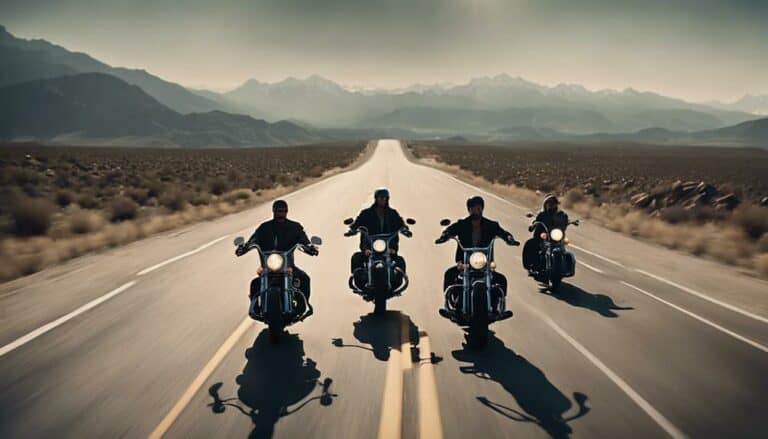If you were to take a closer look at Harley Davidson's journey to success, you might be surprised to learn that over 80% of the motorcycles they have produced since 1903 are still on the road today.
But how did this iconic American brand manage to achieve such longevity and admiration? The answer lies in a combination of strategic decisions, unwavering commitment to quality, and a deep understanding of their target audience.
Would you like to explore the key factors that propelled Harley Davidson to the pinnacle of the motorcycle industry?
Key Takeaways
- Strategic adaptability during challenges and recessions ensured sustained growth.
- Cultivation of brand loyalty through community engagement and innovative designs.
- Minimal advertising with a focus on building a passionate enthusiast community.
- Successful international expansion by addressing market obstacles and fostering global demand.
Historical Background of Harley-Davidson
Harley-Davidson's evolution into an iconic motorcycle manufacturer was deeply rooted in its historical journey of innovation and perseverance in the face of challenges. The company's success can be attributed to various pivotal moments.
By receiving temporary relief under U.S. trade laws in 1983, Harley-Davidson was able to weather the storm and emerge as a market leader, capturing a remarkable 56% share of the large motorcycle market. During the challenging times of the 1981-1982 recession, the company showcased its resilience by successfully adjusting its strategies to stay afloat and maintain its position.
Furthermore, Harley-Davidson focused on enhancing manufacturing efficiency and product quality, which played a significant role in its rise to prominence. The growth in U.S. exports of motorcycles and parts from 1987 to 1998 further fueled Harley-Davidson's success, while the repeal of tariff surcharges in 1987, following the U.S. International Trade Commission's findings, provided additional support for the company's expansion and development.
Brand Loyalty and Community Engagement
Amidst its historical journey of innovation and resilience, Harley-Davidson's brand loyalty and community engagement stand as pillars of its continued success in the motorcycle industry.
The Harley Owners Group (HOG), boasting over 1400 local chapters worldwide, plays a pivotal role in fostering brand loyalty among enthusiasts. HOG members exhibit a remarkable 30% higher expenditure on Harley items, underscoring their deep engagement and loyalty within the community.
Leveraging this brand community, Harley actively invests in customer engagement, assigning dedicated staff to nurture relationships within these groups. Furthermore, revenue streams from selling non-bike items to community members significantly contribute to the brand's overall success and heightened engagement levels.
Harley-Davidson's rich association with American military history, particularly its sales during wartime, further bolsters brand loyalty and community engagement, creating a unique bond with enthusiasts rooted in tradition and patriotism.
Innovation in Motorcycle Design
Innovative motorcycle design at Harley-Davidson has been a cornerstone of the company's enduring success and industry leadership. By focusing on creating high-quality and distinctive motorcycles, Harley-Davidson has managed to capture the essence of customer preferences, establishing itself as an iconic brand in the market. The company's commitment to innovation in design has resulted in the development of legendary models like the Sportster, Dyna, and Touring families, each catering to a different segment of riders.
Harley-Davidson's ability to constantly evolve and enhance its motorcycle designs hasn't only solidified its brand image but also fostered customer loyalty. This dedication to innovation has been instrumental in maintaining the company's position as an industry leader, allowing it to dominate the market and remain a top choice for riders globally. By staying true to its roots while embracing modern trends, Harley-Davidson continues to set the standard for excellence in motorcycle design, ensuring its continued success and relevance in the industry.
Marketing and Advertising Strategies
With a strategic focus on community building and product excellence, Harley-Davidson has redefined traditional advertising methods to drive brand recognition and loyalty. Here are four key points to consider:
- Community of Enthusiasts: Harley-Davidson prioritizes building a community of enthusiasts rather than relying heavily on advertising. This approach fosters a sense of belonging and loyalty among customers.
- Product Merits Over Heavy Advertising: Despite minimal spending on advertising, Harley-Davidson has reported a remarkable 16.2% annual sales growth since 1987. The company's emphasis on product quality speaks volumes to customers.
- Brand Reach Expansion: Harley-Davidson successfully extended its brand reach beyond motorcycles to industries like fashion and food. This strategic move helped the company regain customer loyalty and attract new audiences.
- Management Engagement: Management at Harley-Davidson actively engages with customers by sharing their passion for motorcycles. By participating in rallies and owning Harley bikes, management showcases their commitment to the brand, further strengthening customer loyalty.
International Expansion and Global Presence
Harley-Davidson's successful international expansion and global presence have been instrumental in solidifying its position as a prominent player in the global market. The company's exports of motorcycles and parts grew by 15% annually from 1987 to 1998, with the York, PA assembly plant alone exporting 22% of its motorcycles.
Notably, Harley-Davidson has made significant inroads into the Japanese market, where the demand for its motorcycles has been increasing at a remarkable 43% annual rate since 1996. This market presence in Japan has been a key factor in the company's global success.
Additionally, Harley-Davidson's collaboration with the U.S. government to address obstacles in foreign markets and support American exports has further facilitated its sales expansion worldwide. Recognized as one of the 100 best-managed companies by Industry Week magazine, Harley-Davidson's strategic approach to international expansion hasn't only enhanced its global presence but also solidified its reputation as a leader in the industry.
Conclusion
You've seen how Harley-Davidson's success story is like a well-oiled machine, with each part working together to create a powerful and enduring brand.
From their rich history to their innovative designs, strategic marketing, and global expansion, Harley-Davidson has revved up to become a true icon in the motorcycle industry.
Their loyal customers and strong community engagement have fueled their journey to success, making them a shining beacon in the world of motorcycles.

